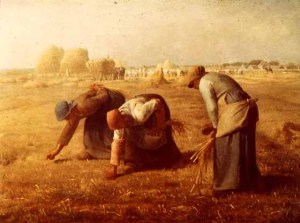There’s a painting with a plain wooden frame that hung, I am told, in my grandparents’ kitchen when my mom was a girl. When she married and started the home in which I was raised, she displayed it in her dining room. Unaware as I then was of its general appeal and the fact that it even hung in the Louvre, I was first attracted to it because of its simple connection to home. As I grew older, I became attracted to its warm earthy hues and simple rural theme. Today I am inspired by its poignant message, of which I am reminded daily as it now hangs (in the same old wooden frame) in my home not far from where my family shares its meals.

It’s a simple painting, and a complicated one.
It can be seen hanging in the Taylor’s living room in old episodes of TV’s classic ‘The Andy Griffith Show,’ a symbol of Mayberry’s simple ways and people. And while the real Andy Griffith is revered today as the spiritual godfather of the North Carolina Democrat Party, he was no socialist. Rather, his loving yet firm, altruistic yet practical ways could be considered, as much then as today, the embodiment of what makes America great. Juxtapose this with its complicated origin.
Having been painted shortly after the French Revolution of 1848, it is no surprise that Millet was at first accused of being apologetic to the workers and socialist movement. Millet insisted that he had no political agenda. He was, however, irked that the man who bought it low balled him by 25% of his asking price and refused to budge. Desperate, Millet took the money, but kept its embarrassingly low sale price a secret his whole life. It is ironic that fourteen years after the artist’s death, it sold for one hundred times what he originally got for it while Millet’s family continued to struggle financially.
My maternal grandfather (the one who bought the old reproduction that now hangs in our house) was a political historian with many tolerant world views. After serving multiple campaigns as a medic (many of whom, I recently learned, were professed pacifists) during WWII in the South Pacific, he attended the University of Utah where he wrote his masters thesis on the political philosophy of H.G. Wells. A great admirer of Hinduism and Gandhi, he studied on a Fullbright teaching scholarship in India for a summer and, for a time, wore a beard and pagri. It makes me wonder about the aspects of the painting’s message that must have appealed to him.
Fast forward to forty years later . . . As a student at Brigham Young University (unable to wear a beard or pagri), I visited my then-girlfriend-soon-to-be fiance’s home for the first time, and there it was again, hanging in the sewing room next to another Millet painting of two peasants praying. I thought it was a sign! Then again, most recently, when our family moved to our current home, we were both delighted to see it hanging in the Relief Society room in our church building where we meet for Sunday School.
So, what is its universal appeal, and why do people who hold such seemingly varied worldviews claim this painting as their own? Having done a little research on it one recent Sunday afternoon after church, I’d like to share some of its fascinating history and consider some of the possibilities for its transcendent appeal.
Gleaning
In the old days, according to religious code, farmers were to leave the corners of their fields unharvested. They were also to leave any leftovers, allowing a generous portion of their work to be harvested by the poor, which included widows, orphans and strangers. Similar practices were carried out in vineyards and orchards, and this served as the basis of one of society’s first welfare systems.
While at first glance this might seem like a purely benevolent act on the part of the rich landowners, a primary reason for upholding this practice was to keep the peasant masses from rising up against them. In a stratified social structure with little opportunity for upward mobility—one most often was born into and died in the same social caste—providing handouts to the poor seemed like the most convenient way of containing them, keeping them from being too disgruntled at their state. (I say handouts while acknowledging that the act of gleaning does not appear to be quite the same as waiting in a welfare line, but you get the idea.)
From an art historian’s perspective, if you look closely at a good reproduction of this painting, Millet seems to have made it clear that the light and abundance is only near the horizon where the wealthy landlord looks over his bounteous harvest, while the peasants are in muted tones and shadows, clearly part of a separate existence. Further reinforcing this theme, the vanishing points created by the backs of the working peasants in the foreground are completely unrelated to the bounty in the background.
Some Personal Commentary
Many artists have idealized the nobleness of working peasants who eat by the sweat of their brows and burden of their backs. While a student, I was very drawn to the work of western artists who celebrated honest toil, in particular Maynard Dixon and Mahonri Young. Often, I felt guilty for the relative “easiness of the way” and went through periods of time when I craved physical work, even dropping out of college at one point to work as a manual laborer.
Prior to my engineering studies, as a student of Russian literature, I remember with great fondness sharing bread and honey with friends on campus lawns and on hikes in Utah’s beautiful mountains. We discussed the works of Pushkin, Gogol, Lermontov and others. I was a devoted scholar of Tolstoy, who strove toward the simplicity of the peasant life, yet always seemed to fail at realizing his impossible ideals.
Looking back on this time, I realize that I have even more questions now than I had then. While I once saw so clearly the need for mankind to work towards a more just and efficient social order based on honest work and brotherly love (and, later, engineering efficiency), I recognize now the limitations of this ideal under the present circumstances.
The protestant ethic of hard work, freedom to pursue one’s self-interest, and religious conservatism, all pilars upon which American economic supremacy were built for two hundred years, appears to be in the process of being replaced by something else. I have some loosely held opinions along with some firm convictions regarding the matter, but after going on and on in my initial draft of this post, I’ll spare you the agony. I really don’t know where we’re headed in the next couple decades.
I will, however, just share an excerpt from a 1978 commencement address by a Russian academic entitled, “A World Split Apart.” It was given at a time when the “split” was much more defined, consisting of two world superpowers that flexed their military muscle at each other, flirting with what could have brought the world to ruin. It’s interesting to contemplate the “split” that we now see, one that is much more ambiguous, but no less disastrous . . .
When the modern Western States were created, the following principle was proclaimed: governments are meant to serve man, and man lives to be free to pursue happiness (See, for example, the American Declaration) . . . In the process, however, one psychological detail has been overlooked: the constant desire to have still more things and a still better life and the struggle to obtain them imprints many Western faces with worry and even depression, though it is customary to conceal such feelings. Active and tense competition permeates all human thoughts without opening a way to free spiritual development. The individual’s independence from many types of state pressure has been guaranteed; the majority of people have been granted well-being to an extent their fathers and grandfathers could not even dream about; it has become possible to raise young people according to these ideals, leading them to physical splendor, happiness, possession of material goods, money and leisure, to an almost unlimited freedom of enjoyment . . . Today, well-being in the life of Western society has begun to reveal its pernicious mask.” -Alexander Solzhenitsyn
Here’s a link to the complete address.


